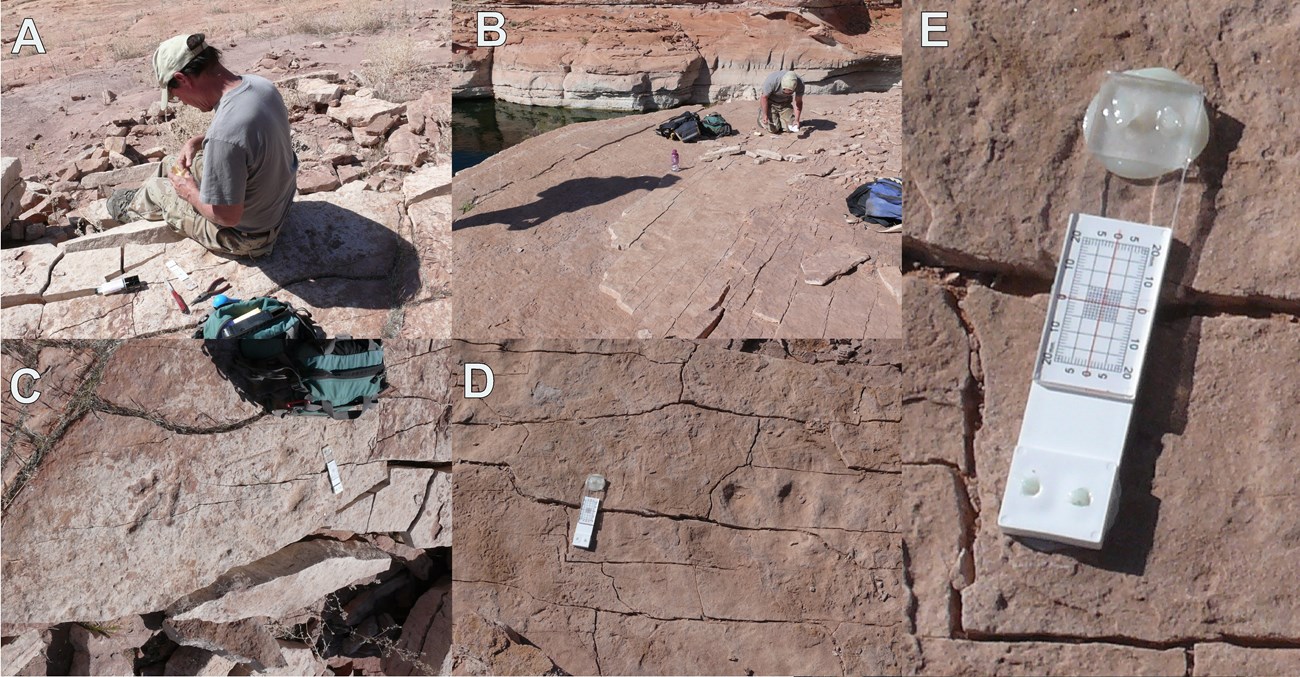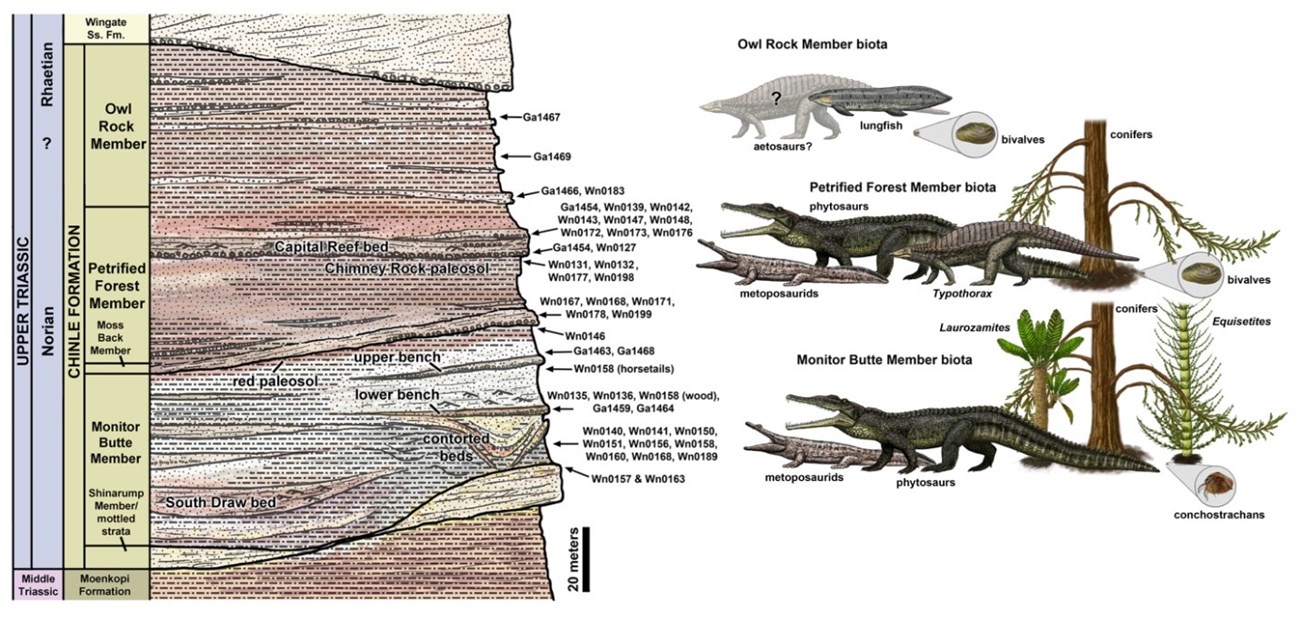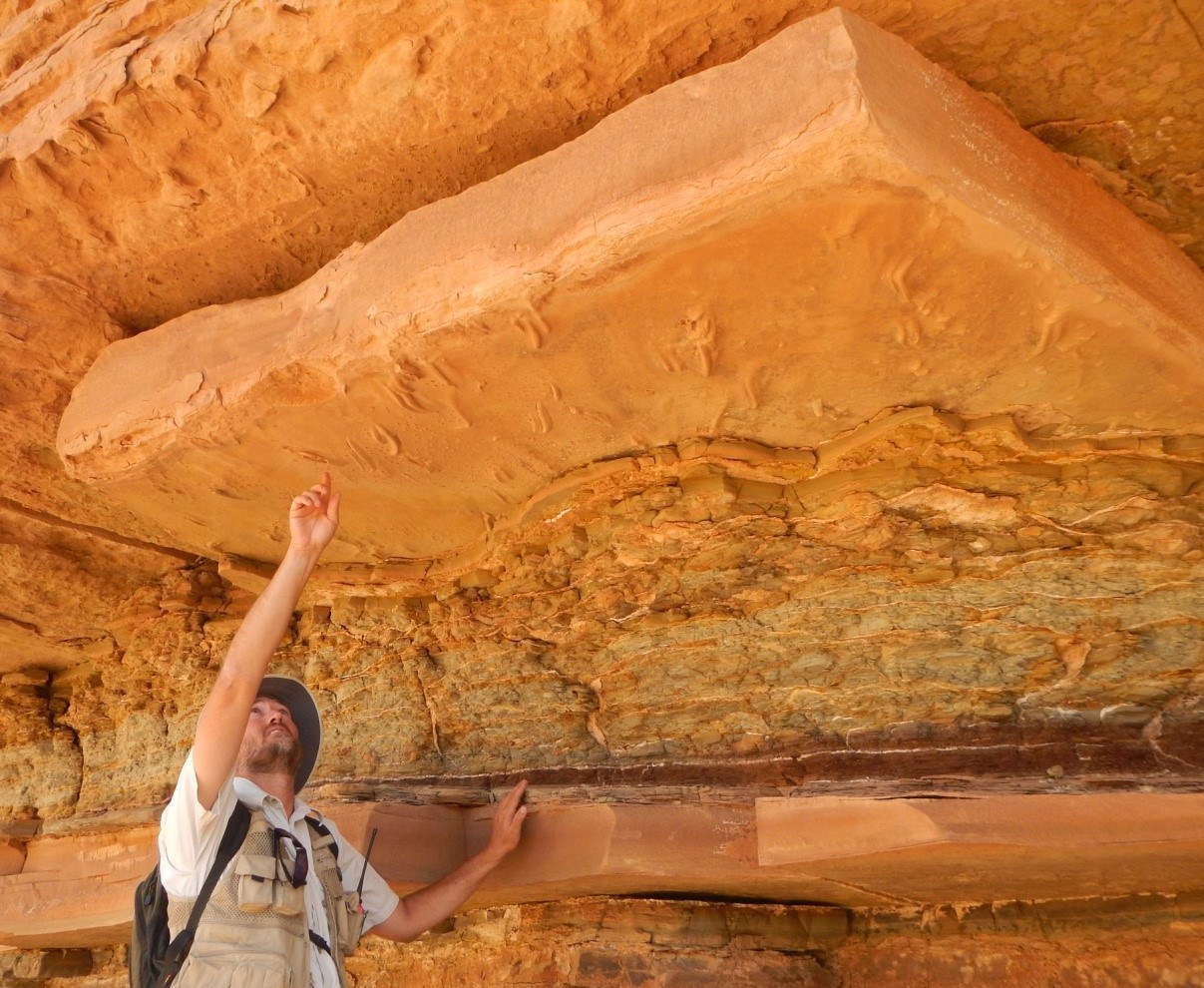Part of a series of articles titled Park Paleontology News - Vol. 14, No. 1, Spring 2022.
Article
A 20-year Partnership between the Utah Geological Survey and the National Park Service to Inventory and Monitor Fossil Resources in Utah's National Parks

Donald DeBlieux1, James Kirkland1, and Vincent L. Santucci2
1Utah Geological Survey
2National Park Service Paleontology Program
Through a systematic program of paleontological resource inventory and monitoring, the National Park Service (NPS) has been at the forefront of paleontological resource management on public lands. The Paleontology Section of the Utah Geological Survey (UGS) has been a valuable partner in this effort. Over the past 20 years, the UGS has worked with the NPS to inventory and monitor paleontological resources in many of the national parks in Utah. This partnership has been remarkably successful and serves as a great example of what can be accomplished when government agencies work together towards a common goal. Our collaborative work has helped inform park personnel to more effectively manage the paleontological resources in their parks, enhance visitor experiences, and provide geological and paleontological information to reconstruct past life and ecosystems. Some of the NPS units where the UGS has conducted paleontological resource inventories include Arches National Park (ARCH), Canyonlands National Park (CANY), Capitol Reef National Park (CARE), Glen Canyon National Recreation Area (GLCA), and Zion National Park (ZION).
Utah has one of the best fossil records of any place on Earth and the national parks are no exception. Fossils found in Utah's national parks range in age from the Paleozoic through the Holocene. Because many of Utah’s parks showcase the spectacular red rock scenery of the Colorado Plateau, most of the fossils are found in the Mesozoic-age rocks that form this scenery. Triassic- and Jurassic-age rocks are particularly well represented. The Triassic Period and Triassic–Jurassic transition have been the focus of considerable research because this interval is associated with a major evolutionary radiation and subsequent extinction event linked with the rise of most modern terrestrial animal groups. Because the Colorado Plateau preserves so many rocks of this age, it has been one of the best places to study this interval. One of the most fossil-rich formations on the Colorado Plateau is the Triassic-age Chinle Formation. Much of what we know about Late Triassic terrestrial ecosystems has been discovered by studying fossils found in this formation. Many of the national parks in Utah have exposed Chinle Formation rocks and we have concentrated many of our surveys in that formation because of the high potential for scientifically significant fossils. We have collaborated with researchers from many different institutions and our research dovetails with other research being done on these rocks. We have also surveyed Jurassic-age rocks. Many of these rocks are sandstones that rarely preserve body fossils and are more likely to preserve tracks. The surveys we have conducted have led to important discoveries that help to refine our knowledge of the geology of the region. All in all, we have found and documented hundreds of new fossil localities in Utah's national parks. Because so much work has been done, we can only give an overview of a few important results.

Arches National Park
Because of the faulting and erosion associated with the Salt Valley anticline that helped to form the numerous arches for which the park is famous, Arches has a great diversity of Mesozoic-age geological formations. Along with Dinosaur National Monument, Arches is one of the few Utah parks to contain significant amounts of upper Mesozoic dinosaur-bearing strata. These include the world-famous Jurassic-age Morrison Formation and the Early Cretaceous-age Cedar Mountain Formation. Numerous dinosaur sites have been documented in Arches. One highlight of the work in the park is the discovery of a tracksite in the Cedar Mountain Formation that preserves several kinds of dinosaur footprints, including the track of a dromaeosaur probably related to Deinonychus. Also found at this site are interesting traces that we think are feeding traces made by an animal such as a bird or pterosaur that was floating in shallow water and probing the bottom with its beak. Many other tracksites are found in lower Mesozoic strata at Arches including in the Moenkopi, Chinle, Wingate, and Kayenta Formations and the Navajo Sandstone. One noteworthy find in Arches was a portion of a dinosaur skeleton in the Kayenta Formation, the first dinosaur body fossil found in the Kayenta of Utah. The fossil is currently under study and is thought to belong to a theropod dinosaur similar to Dilophosaurus.

Figure 3. Dinosaur tracks and enigmatic feeding traces from the Cedar Mountain Formation in Arches National Park. A) Overview of theropod track area. White box indicates area of detail in C. B) Overview of a portion of the feeding trace area. White box indicates area of detail in D. C) Detail of lower theropod track. D) Detail of some of the best examples of feeding traces. White scale bar = 1 cm.
Zion National Park
In terms of parks to work in, it doesn't get much more spectacular than Zion. Whether camping or staying in ranger housing during the winter, there is nothing like waking up with the sunrise lighting up the thousand-foot-tall cliffs of Navajo Sandstone. The western part of the main park area near Mount Kinesava contains excellent outcrops of Triassic-age Chinle Formation. This is the formation in the park that has the greatest potential for body fossils and we have documented many sites having fossils of phytosaurs, aetosaurs, and fish. This area has petrified logs along a trail formerly known as the Petrified Forest Trail, which has been renamed the Chinle Trail to help reduce vandalism and theft of fossil wood and logs. During our work in Zion we collaborated with Chinle Formation expert Jeff Martz (University of Houston) who identified the colorful rocks above the basal Shinarump Member of the Chinle Formation in Zion as belonging to the Cameron Member. These rocks had been identified by previous researchers as the Petrified Forest Member. Therefore, these are some of the oldest Chinle Formation rocks preserved above the Shinarump in Utah.
Other collaborative work in Zion includes measuring a section and sampling for isotope geochemistry in Blacks Canyon with Celina Suarez (University of Arkansas) to identify the Triassic–Jurassic boundary in the Moenave Formation and correlate it with global climate events. In Zion Canyon, we located and documented dozens of dinosaur tracksites primarily in the Early Jurassic-age Moenave and Kayenta Formations. At the top of the Springdale Sandstone Member of the Kayenta Formation we found that tracks are very common and that this interval constitutes a megatrack surface. We provided the park with PFYC (Potential Fossil Yield Classification) maps based on recently completed UGS 7.5-minute-quadrangle geologic maps to help park management identify areas of high paleontological sensitivity.

Glen Canyon National Recreation Area
Our work in Glen Canyon National Recreation Area (GLCA) was done primarily along the shores of Lake Powell using boats for access. Once again, Triassic and Jurassic rocks form the bulk of the rocks found in GLCA. We found many wood and bone sites in the Chinle Formation and many tracksites in the Kayenta and other formations. During our work we found and documented 50 new fossil localities. The importance of documenting these sites becomes ever more critical as lake levels drop and these sites are threatened by erosion and vandalism. We also established several monitoring sites to quantify the amount of movement of fractures in tracksite surfaces to get an idea of erosion rates.

Figure 4. Installing crack monitors at site GLCA#3 in Glen Canyon National Recreation Area. A) Mixing epoxy, B) Installing crack monitor by Anomoepus tracks, C) Crack monitor by Anchisauripus tracks, D) Crack monitor by Anomoepus track, E) Close-up of crack monitor by Anomoepus track showing initial setting of 0,0.
Capitol Reef National Park
The spectacular outcrops of Chinle Formation rocks in Capitol Reef National Park (CARE) are some of the most fossiliferous that we have found in Utah. The Monitor Butte Member and Capitol Reef Bed, which crop out widely in the park, are especially rich in fossil localities. We documented dozens of new localities and once again enlisted the help of Jeff Martz to measure several stratigraphic sections into which the fossils we found were placed. This stratigraphic context is important to allow us to chart the evolution of the plants and animals, and changes in climate through time. The Chinle Formation rocks in CARE tell a fascinating story of climate change driven by plate tectonics as the supercontinent of Pangea drifted northward from the humid tropical belt into the arid subtropical belt during the Late Triassic. During our survey, we rediscovered a site that was first documented during the 1980s that preserves a standing “grove” of the giant horsetail Equisetites. With the help of Jack Wood of the NPS, we collected 3D photogrammetric data and generated a 3D model of the site. Comparing this to photos of the site when originally found allows us to assess the vulnerability of the site to erosion.
One of the observations we made during our project illustrates how these park surveys can yield unexpected benefits to our knowledge of geology. During work in the northern region of the park, we recognized that a large area of rocks from the Cretaceous-age Cedar Mountain Formation are present in an area that had been previously mapped as Jurassic-age Morrison Formation. We returned to the park to document these rocks, and with the help of UGS mapping geologist Grant Willis we are in the process of updating the geologic map of the area.

Canyonlands National Park
Our most recent work in Canyonlands (CANY) began in the fall of 2020 with a survey of the Island in the Sky District (ISKY) using the White Rim Trail for access to the rock outcrops. Prior to our survey, the Utah Paleontological Database, which is managed by the UGS, had two paleontological localities in ISKY. We found and documented more than 70 new sites during our two 10-day field expeditions. Once again, the Chinle Formation was the primary focus of our explorations. We found several bone-bearing sites with fossils of phytosaurs, aetosaurs, and fish, and identified several stratigraphic levels that commonly preserve petrified wood and logs.
Although we concentrated our efforts on the Chinle, CANY has a large amount of Early Triassic Moenkopi Formation and one of the most successful parts of our work was the discovery and documentation of many scientifically significant tracksites in the Torrey Member. The most common tracks found in the Torrey Member are “swim tracks” made by buoyant and semi-buoyant reptiles padding along the bottom while floating in water. Moenkopi swim track expert Tracy Thomson (UC Davis) helped us during the project and remarked that these are some of the best-preserved swim track sites on the Colorado Plateau. We plan to continue our work in the Moenkopi and Chinle Formations of the park as well as explore some of the Paleozoic rocks that have the potential to yield significant vertebrate fossils.

Conclusion
Our collaboration with the NPS over the years has resulted in many important scientific discoveries and documented important fossil resources. We plan to continue our partnership so these resources can be managed for the benefit of the American people and all visitors to the spectacular national parks of Utah.
Selected Bibliography
- DeBlieux, D.D., Kirkland, J.I., Thomson, T.J., Milner, A.R.C., and Santucci, V.L., 2021, Paleontological resource inventory and monitoring Moenkopi and Chinle Formations, Island in the Sky District, Canyonlands National Park, Utah—Phase I: Utah Geological Survey Contract Deliverable, 48 p., 2 appendixes.
- DeBlieux, D.D., Kirkland, J.I., Smith, J.A., McGuire, J.A., and Santucci, V.L., 2006, An overview of the paleontology of Upper Triassic and Lower Jurassic rocks in Zion National Park, Utah, in Harris, J.D., Lucas, S.G., Spielmann, J.A., Lockley, M.G., Milner, A.R.C, and Kirkland, J.I., editors, The Triassic-Jurassic Terrestrial Transition: New Mexico Museum of Natural History and Science Bulletin, v. 37, p. 490–501.
- DeBlieux, D.D., Smith, J.A., McGuire, J.L., Kirkland, J.I., and Santucci, V.L., 2005, Zion National Park Paleontological Survey: Utah Geological Survey Contract Deliverable, 71 p., 5 plates, 4 appendixes.
- Kirkland, J.I., DeBlieux, D.D., and Willis, G.C., 2020, Mid Mesozoic geology and paleontology at northern Capitol Reef National Park (CARE): Utah Geological Survey Contract Deliverable, 67 p. 3 appendixes.
- Kirkland, J.I., Madsen, S.K., DeBlieux, D.D., and Santucci, V.L., 2011, Establishing a paleontological monitoring test site at Glen Canyon National Recreation Area: Brigham Young University Geology Studies v. 49(A), p. 51–60.
- Kirkland, J.I., Madsen, S.K., DeBlieux, D.D., Ehler, J.B., Weaver, L. and Santucci, V.L., 2010, Final report for paleontological resources inventory and monitoring at Glen Canyon National Recreation Area: Utah Geological Survey Contract Deliverable, 165 p., DVD; text, GLCA locality data base, GIS data, 2 plates, scale 1:125,500.
- Kirkland, J.I., Martz, J.W., DeBlieux, D.D., Santucci, V.L., Madsen, S.K., Wood, J.R., and Payne, N.M., 2014, Paleontological resources inventory and monitoring Chinle and Cedar Mountain Formations, Capitol Reef National Park, Utah: Utah Geological Survey Contract Deliverable, 123 p. GIS data, 2 plates, 6 appendixes.
- Lockley, M. G., White, D., Kirkland, J. and Santucci, V., 2004, Dinosaur Tracks from the Cedar Mountain Formation (Lower Cretaceous), Arches National Park, Utah: Ichnos, v. 11, p. 285–293.
- Madsen, S.K., Kirkland, J.I., DeBlieux, D.D., Santucci, V.L., Inkenbrandt, P., and Tweet, J.S., 2012, Paleontological resources inventory and monitoring Arches National Park, Utah: Utah Geological Survey Contract Deliverable, 120 p., DVD; ARCH locality database, GIS data, 1 plate, scale 1:125,500. 5 appendixes.
- Martz, J.W., Kirkland, J.I., DeBlieux, D.D., Suarez, C.A., and Santucci, V.L., 2015, Stratigraphy of the Chinle Formation (Upper Triassic) and Moenave Formation (Upper Triassic-Lower Jurassic) in the southwestern part of Zion National Park, Washington County, Utah: Utah Geological Survey, Contract Deliverable, 102 p.
- Martz, J.W., Kirkland, J.I., Milner A.R.C., Parker, W.G., and Santucci, V., 2017, Upper Triassic lithostratigraphy, depositional systems, and vertebrate paleontology across southern Utah: Geology of the Intermountain West, v. 4. p. 99–180.
- Santucci, V.L., and Kirkland, J.I., 2010, An Overview of National Park Service Paleontological Resources from the Parks and Monuments in Utah, in Sprinkel, D.A., Chidsey, T.C., Jr., and Anderson, P.B., editors, Geology of Utah’s Parks and Monuments: Utah Geological Association Publication 28 (3rd edition), p. 589–623.
- Suarez, C.A., Knobbe, T.K., Crowley, J.L., Kirkland, J.I., and Milner, A.R.C., 2017, A chronostratigraphic assessment of the Moenave Formation, USA using C-isotope chemostratigraphy and detrital zircon geochronology—implications for the terrestrial end Triassic extinction: Earth and Planetary Science Letters, v. 475, p. 83–93.
Related Links
- Arches National Park, Utah—[Geodiversity Atlas] [Park Home] [npshistory.com]
- Canyonlands National Park, Utah—[Geodiversity Atlas] [Park Home] [npshistory.com]
- Capitol Reef National Park, Utah—[Geodiversity Atlas] [Park Home] [npshistory.com]
- Glen Canyon National Recreation Area, Arizona and Utah—[Geodiversity Atlas] [Park Home] [npshistory.com]
- Zion National Park, Utah—[Geodiversity Atlas] [Park Home] [npshistory.com]
- NPS—Fossils and Paleontology
- NPS—Geology
Last updated: March 30, 2022
